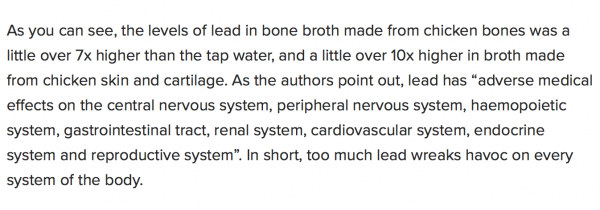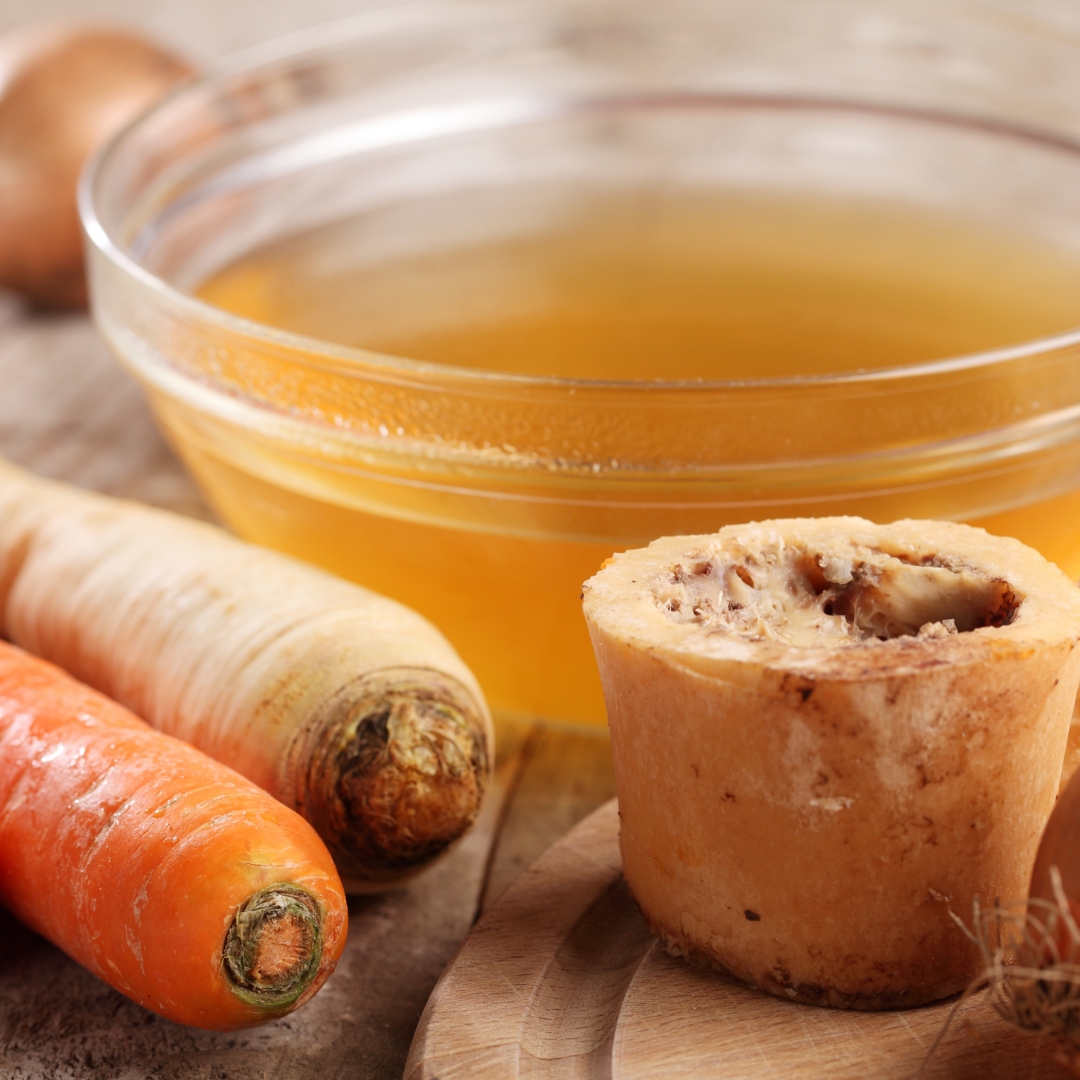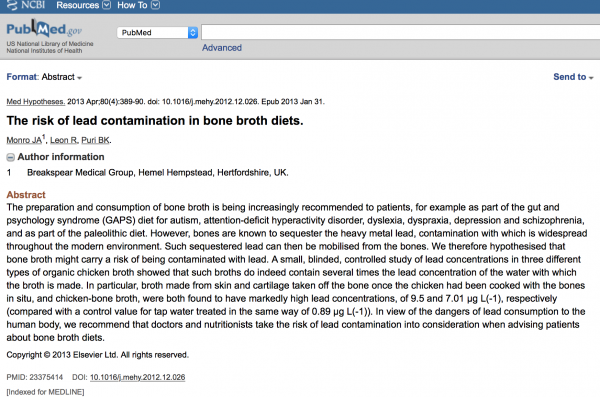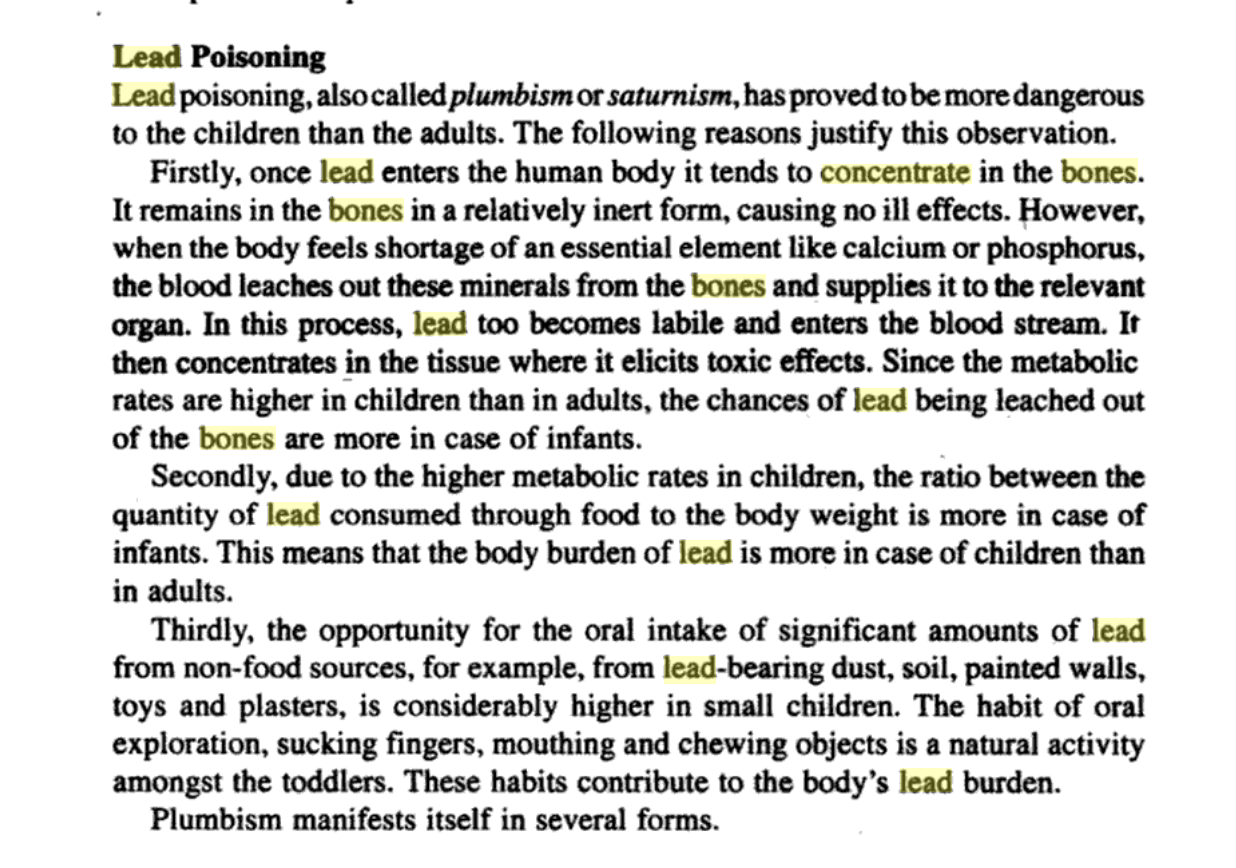Q. Is there an unsafe level of Lead in bone broth? A. There can be, so you need to be careful in sourcing your bones.
For those new to this website:
Tamara Rubin is a multiple-federal-award-winning independent advocate for childhood Lead poisoning prevention and consumer goods safety, and a documentary filmmaker. She is also a mother of Lead-poisoned children (two of her sons were acutely Lead-poisoned in 2005). Since 2009, Tamara has been using XRF technology (a scientific method used by the U.S. Consumer Product Safety Commission) to test consumer goods for toxicants (specifically heavy metals — including Lead, Cadmium, Mercury, Antimony, and Arsenic). Tamara’s work was featured in Consumer Reports Magazine in February 2023 (March 2023 print edition).
Question: Is there an unsafe level of Lead in bone broth?
Original article title: “YES, there are high levels of Lead in bone broth (and NO, it is not safe to ingest Lead)!“
Answer: Maybe. (And most likely, “yes.”)
There are several different studies to look at and different considerations to take into account when answering this question.
Unfortunately, more often than not, “health-gurus” and “health bloggers” including some with MEDICAL credentials will (in their writing) attempt to diminish or discount the impact of the possible (and likely) concentrated levels of Lead found in bone broth.
However, there are some facts that just cannot be ignored when exploring this concern:
- Lead bio-mimics calcium when absorbed by natural structures.
- Bones are high in calcium.
- That is why bones are a storehouse for Lead (in all animals).
- If an animal is exposed to Lead in their environment, then their bones will absorb and accumulate this Lead in the place of calcium.
- This Lead can come from many environmental sources (even in 2018):
- from feed (many documented sources for contamination here)
- from tractors and other farm vehicles’ exhaust (yes, many of these — legally — still use Leaded fuel!)
- from soil (which can be contaminated with Lead from historic Leaded pesticide use, historic Lead paint use on equipment and structures and related renovation/ sanding/ power washing, and historic and current Leaded gasoline use)
- from both modern and legacy paint and industrial finishes on farm equipment and buildings (yep, Lead is still legal in lots of “non-residential” paint as well!)
- When you make broth from these bones or cartilage (vs. from the meat of the animal) — be it a chicken or a cow or a pig, you are using the most Leaded part of the animal to make the broth.
- The broth, which is often simmered for hours or even days, will (by nature and design) pull all of the “nutrients” and “minerals” out of the bones and into the broth … this includes Lead.
There is no valid justification (not a single one) to intentionally concentrate Lead in a single food source to add it to your diet. Just don’t do it.
Here are two ways to help make sure your broth will likely have lower levels of Lead:
- Make your broth out of the meat of the animal.
- Source your broth ingredients from known farms, farms where you have EVIDENCE that they do not use leaded gasoline (which, as stated above, is still legal to use in farm equipment) and does NOT have old Lead painted farm buildings (it’s also perfectly legal for even organic farms to have old Lead-painted buildings, vehicles, and industrial equipment!). Also be able to ensure your ingridients were NOT grown in soil that is lead contaminated from previous/ legacy Leaded pesticide use, and is NOT near a freeway or small airport that might have generated a lot of Lead residue from Leaded gasoline use (in the past for freeways, and in the present for small airports). You guessed it — small planes still, legally, use Leaded fuel that may have contaminated the soil!
If you appreciate this advocacy work,
please consider contributing to our Lead Safe Mama, LLC #GoFundME! Thank you!
The quote below is from the following article (linked here). In spite of this quote, this “health blogger” is still advocating for the use of bone broth as a healing substance!

- The Healthy Home Economist
- And one from Dr. Josh Axe
These blogs are citing each other as “evidence” for disregarding the settled science in this matter!
Like with Earthpaste, these people are too passionate about the alleged health benefits of something, to even begin to realistically consider or assess the actual, scientifically measured, known health risks of that same thing. Their passion is blinding them to the truth.
Here’s someone who knows their stuff and has a website! NutritionFacts.org
Watch this amazing video ^^^^
Here is the link to the actual 2013 bone broth study abstract:
Update 9/4/2017
Here’s some additional info for folks who question the presence of a concentration of Lead in bones. There are many scientific journals and articles discussing the fact that Lead is concentrated in bones because Lead bio-mimics calcium and bones are calcium-dense. (The articles have nothing to do with broth, but with bone development in biological structures — including animals such as chickens, cows, and humans.) Here is one example I found without too much googling:
From the book: “Fundamental Concepts of Environmental Chemistry” (2005).
As always, please let me know if you have any questions!
Thank you for reading and for sharing this work.
Tamara Rubin
#LeadSafeMama
Never Miss an Important Article Again!
Join our Email List













Thanks for bringing this issue to our attention. However, though it’s not implicitly illegal for farm equipment to use leaded fuel (or small airplanes), it’s virtually impossible to find leaded fuel to put in your vehicle. I do agree with you that it is very important to be aware of the source of your food, for many reasons including this one. To argue that bone broth is inherently dangerous, however, is a flawed argument. The bone broth will not contain elevated levels of lead if the animals were not exposed to lead. No one is advocating that people “drink broth with high levels of concentrated lead in it”. Broth is amazingly healthy for us if it isn’t contaminated. It’s very depressing that we have to be so careful these days. We are swimming in toxins. That’s why I choose to grow my own food. When possible, everyone should be buying their food directly from farmers so they know what goes into their food, and so that they support the small farmers that are growing nutritious, wholesome food. There are many ways food can become contaminated in the industrial system. Thanks, again.
It’s not difficult at at all to procure leaded gasoline, unfortunately. It’s very commonly used in small airplane avgas – and there is a big fight now to try to get it outlawed because these small airports are often near farms and schools and communities with young children!
…And there’s a perfectly good reason for it still being used by small (piston-engine) airplanes – preventing “engine knocking” combustion patterns and leaking around seals and such that can make flying a plane destructive. Some small planes can use modern, unleaded gasoline, but many high-performance engines used in the small commercial-type aircraft that are a lifeline in many parts of the nation can’t (this is not true of jets, because jet engines operate entirely differently. They can use kerosene).
Although I agree that it is in nobody’s interest to be exposed to lead (including pilots), there is currently no solution, though it is being researched and worked on, I understand. It will be great when they do find one.
When I worked in government public relations, I read complaints nearly daily from people who were outraged about this or that without taking the time to understand the issue from all angles (i.e., maybe the regulation you are insisting on changing is actually governed by statutory authority, which takes legislative action, or you’re misunderstanding the science). This is not a simple issue, and it needs more than simplistic answers like “outlawing” avgas.
-A Pilot’s Wife
I appreciate reading your opinion, Nicole. thank you!
So is it possible to test for lead in a liquid item? it would really settle the question…
Yes it is. I don’t have a lab I use currently, however if you do send it to a lab, you would want to make sure to ask them to test down to food toxicity levels, specifically in parts per billion (not giving you results in parts per million.). For context, water is considered toxic and unsafe (depending on whose standards you use) at either 5 parts per billion or 15 parts per billion.
So how do you get glycine, proline and the other amino acids not so plentiful in muscle / organ meats? Lead isn’t good, but neither is a methionine-rich, glycine-poor diet which increases your likelihood of choline deficiency and fatty liver disease.
Has anyone studied broth made from other animals? Do we know how it compares with chicken?
Has anyone tested supplements based on bone for lead content eg bonemeal, calcium hydroxyapatite? Is milk affected too? I’m pretty sure my EBF son’s elevated lead on a hair test was due to lead via my milk (I was calcium deficient but neither I nor my other son had elevated lead on the hair test).
“Lead isn’t good, but neither is a methionine-rich, glycine-poor diet which increases your likelihood of choline deficiency and fatty liver disease.”
Fatty liver disease (FLD) and choline deficiency are not linked to consumption of bone broth, either as a cure or cause. I have searched Google Scholar, asked Google AI, asked ChatGPT and all of them are drawing a blank. Do you have a study or authoritative source you can link, please?
http://redmond.life/prop65/is-lead-safe-any-amount/
Can you please tell me your response to this from Redmond Clay, as it is how I understand clay works. Through bonding and eliminating, not “leaching” or leaving behind. .
This just simply isn’t true. There are a bunch of reasons listed why bone broth might contain lead and one flawed study that doesn’t take into account the types of animal bones used, the quality of the water or the utensils used during cooking. Bone Broth does not inherently contain lead. It all goes back to the quality of the water, the way the animals were raised (CAFO vs. limited human interference) and the cooking utensils used in the process.
I have sent my bone broth in to be analyzed by a 3rd party laboratory and there are no detectable levels of lead in either of the 2 samples I sent in. It’s not my opinion, I have factual evidence that shows there is no lead.
What broth do you use?
I would love to know which bone broth you use. I add it to drinks/smoothies multiple times a day.
If you have tested your bone broth (down to a decent level of detection, say 4 ppb lead) and it is non detect, it’s fair to say yours is non-detect, but it’s not fair to describe the entire article as untrue, after all the article has a study showing some bone broth DOES have lead!
What source of water was used to make the bone broth? Is it possible that the water had high levels of lead and it became concentrated as it cooked down?
I would recommend reading the study to see if it contains the info you ask, and even emailing the study authors. Please post their response here! 🙂
Do you really think theae blogfers you mentioned are actually trying to convince people it is safe to ingest lead??!!! Wow. You also place the words nutrients and minerals in quotation s as if bone broth doesn’t have these. Again, wow. This is the first time I’ve heard of this, so I’m not disputing what you’ve said. I would be hard-pressed to read any more of your articles, though, because of the condescending, deceptive way this one is written.
Some influencers do try to convince their followers that leaded products are safe so they get money from affiliate sales. Who is doing it and who is not doing it is a matter of debate, not one I care to get into. Isn’t hawking leaded products the real deception?
So, is it safe to just make chicken stock and drink that? That’s what I do. My son has neurological issues. Just want to make sure im doing the right thing. So much conflicting info!!!!
Chicken stock is less likely to have high levels of lead (as compared to stock made from bones.)
It does seem it depends on the exact animal/farm you’re making bone broth from. I also had a friend whose child had lead poisoning who had her chicken broth tested since they were on a WAPF type diet and consuming chicken bone broth daily. Her broth was negative for lead. Her chicken was from a So Cal beyond organic family farm.
But if you haven’t tested your broth or bones I don’t see how you can know your broth is lead free.
I am confused. It seems to say that skin and cartilage had high levels of lead too. And they didn’t test making broth with just the meat… So maybe that would have been high too?
Sounds concerning doesn’t it?
Can you not test lead in water? So how is it not able to be tested in liquid? Isn’t water much higher in lead the the bone broth you are mentioning? What about the nutrient synergy of calcium and selenium in binding lead? What about other animal by products not farmed chicken, such as heritage chicken? What about writing a blog on a series of studies instead of one and claiming truth? Funny you mention people as pseudoscience but this appears to be exactly what this blog is. I appreciate this blogger who actually takes how nutrients and metals work together into consideration, and also doesn’t use scare tactics. https://chriskresser.com/bone-broth-and-lead-toxicity-should-you-be-concerned/
There is no instance in which lead “works together” with nutrients.
There is no amount of lead that is safe in drinking water.
The federal hazard level for lead in water (the EPA standard) is not protective of children’s health. Scientists agree.
Your drinking water SHOULD be 0 (ZERO) ppb (parts per billion) lead, but is considered toxic for ingestion (by scientists and those with children’s health as a primary concern… not federal agencies) at 5 (FIVE) parts per billion (ppb.)
Let’s just go over the results of that 2013 bone broth study.
Tap water had a lead concentration of 0.89μg/l.
Chicken bone broth had a lead concentration of 7.01μg/l.
The US Environmental Protection Agency (EPA) has established a safety threshold of 15.00μg/l.
End of story.
The EPA threshold is not based on current science. It is not protective of children’s health. It is based on what the Feds felt was achievable as a standard by industry. The new recommended safety level for lead in water is 5 ppb (as a level that is protective of children’s health.) End of Story.
Bone broth is also ULTRA high in glutamate…and it is contraindicated for those with neurological & seizure disorders. For those with anxiety disorders, glutamate will enhance them 🙁
I forgot the link for my post above 🙁 https://www.seleneriverpress.com/the-dark-side-of-bone-broth/
Interesting info!
To quote your article:
“When you make broth from these bones (vs. from the meat of the animal) – be it a chicken or a cow or a pig, you are using the most leaded part of the animal to make the broth.”
“There is no valid justification (not a single one) to intentionally concentrate lead in a single food source to add it to your diet. Just don’t do it. Make your broth out of the meat of the animal.”
If you read the study (instead of just the abstract) it says the following lead concentrations were found:
– 9.5 ugL for broth made with skin and cartilage
– 7.01 ugL for broth made with bones
– 2.3 ugL for broth made with meat
– 0.89 ugL for the lead found in tap water cooked alone
If readers listen to you and consume broth from the meat, according to this study, they will be consuming far more than the EPA accepted level of lead.
Yet, you state in the comments above:
—————
“There is no amount of lead that is safe in drinking water.
The federal hazard level for lead in water (the EPA standard) is not protective of children’s health. Scientists agree.
Your drinking water SHOULD be 0 (ZERO) ppb (parts per billion) lead, but is considered toxic for ingestion (by scientists and those with children’s health as a primary concern… not federal agencies) at 5 (FIVE) parts per billion (ppb.)”
—————
I agree with you. However, it appears your intention was to discredit bone broth as unsafe instead of actually read the study. If you believe this study, you should revise your recommendation about the meat (or perhaps look a little closer and wonder if this study is flawed).
Now, you asserted that bones are “the most leaded part of the animal,” yet in this study (even in the abstract), the skin and cartilage were the “most leaded.” Somehow, this doesn’t agree with what is known about how animals accumulate metals, nor your statement about “the most leaded part of the animal.” Something isn’t right here, which is what is discussed at length in the Weston A Price and Healthy Home Economist articles by Dr. Kaayla Daniel.
* Side note: These are essentially the same article posted in two different places. I find your claim that they cite each other as evidence to be disingenuous. *
Dr. Daniel goes into the reasons why this study appears to be flawed including the fact that the bones should have accumulated the most lead. She concludes that the chickens used in the sample appear to have been contaminated and I find her reasoning more convincing than your blog post.
Finally, to quote you again: “These guys are all citing each other as “evidence” for disregarding the settled science in this matter!”
One study, literally ONE study (shown to be flawed, in my opinion), does not equal settled science. Science is never settled as long as you can provide compelling evidence to the contrary. You show your bias (which we are all prone to) with that naive statement.
We keep a vegan home. We would personally never consume any bone-broth.
I’m just curious, please don’t get mad for me asking. How many years have you been Vegan and what classification, i.e.: of Vegan would you consider your family? and because everyone has different ‘Reasons’ is your way of eating because of health issues, clean eating, or Ethical reasons for the animals ?Also, did you in the past (before your Vegan way of eating, did you eat the S.A.D. (Standard American Diet) ?
Thank you, Sheri (Former S.A.D. way of eating) 🙂
(Molalla, OR)
I am not vegan.
My husband has been primarily vegan for more than 20 years, vegetarian for nearly 40 years.
We keep a vegetarian home (no cooking meat in the house.)
Some of our children are vegan, some are vegetarian.
We never cook things like chicken in the house, and everyone except my youngest (who is 9) will not eat anything with legs.
I was pretty much raised by wolves (my mother was never around much to feed us) and ate “whatever’ until I was around 15 years old – since then I stopped eating anything with dyes, corn syrup, hydrogenated oil or artificial anything… this kicked into high gear with the birth of my eldest son in 1996 (he is pescatarian now) – we also eat nearly 100% organic.
Can I just say that first off, you can find the same amount of lead in root and leafy vegetables. You do not absorb all the lead your body takes in and in fact, if you are sufficient in calcium levels you may only take in a mere fraction to nothing. Lead contamination is widespread and if you are eating large amounts of rice and other vegetables you could have higher levels than normal. Lead-arsenate was a commonly used pesticide in orchards and cotton fields. A lot of rice crop is grown on old cotton fields and thus why rice can have high levels.
Another study showing lead concentrates in bones: https://www.ncbi.nlm.nih.gov/pubmed/8492331
and here:
https://books.google.com/books?id=EMlxjftDCY0C&pg=PA340&lpg=PA340&dq=bones+concentrate+lead&source=bl&ots=X1asE82Ybj&sig=ezhnBuTjEBFMBuSff44n4Zx0NC8&hl=en&sa=X&ved=0ahUKEwjU5f_Bio3WAhUH5mMKHbcFCLQQ6AEIYTAN#v=onepage&q=bones%20concentrate%20lead&f=false
Just in case this interests those in this thread, there was a follow-up study on several types of bone broth published this year that contains more and new information: https://www.ncbi.nlm.nih.gov/pmc/articles/PMC5533136/
Interesting to note that the meat used for the study in this case was not farmed in the US.
Hi, I’m wondering if you’ve seen this article and what your response to it is: https://www.westonaprice.org/health-topics/bone-broth-and-lead-contamination-a-very-flawed-study-in-medical-hypotheses/
Lol right lol like duh there’s lead copper mercury aluminium cadmium chromium etc… why would you think broth is ok to eat or animal bone. That is tge store house for such toxins not including the dangers of too much calcium and magnesium in your diet and if you mainly only eat greens or have anemia you’re more suceptable to the toxins of lead, copper, etc…
Several things popped into my mind when reading this article that I think add to the discussion;
1) Lead is absorbed in the body through calcium channels and thereby competes with calcium in the body for absorption. (This is probably why lead absorption has been shown to be higher in a person on an empty stomach.) Therefore, to minimize risks of lead absorption, it may be prudent to keep and eye on your calcium levels in general. Vegetarians, and especially vegans may be at higher risk of lead poisoning since they are statistically more likely to be low in calcium and vitamin D. ( Vitamin D helps the body utilize calcium)
2) Bone broth may be one of the safer food options to consume when it comes to foods that are potentially higher in lead. This is because it is also naturally high in calcium, which is also extracted from the bones. Bone broth also has strong healing effects on the gut, which is easy to hypothesize as having a protective effect against absorption of toxins. Therefore the benefits can easily outweigh the risks, especially if you are careful about selecting your source for the bones.
Could you provide any credible science based, research backed links to support your thoughts and assumptions? Any amount of lead in food is unacceptable. And when it comes to lead contaminated foods, like bone broth, the benefits NEVER out the risks of being lead poisoned.